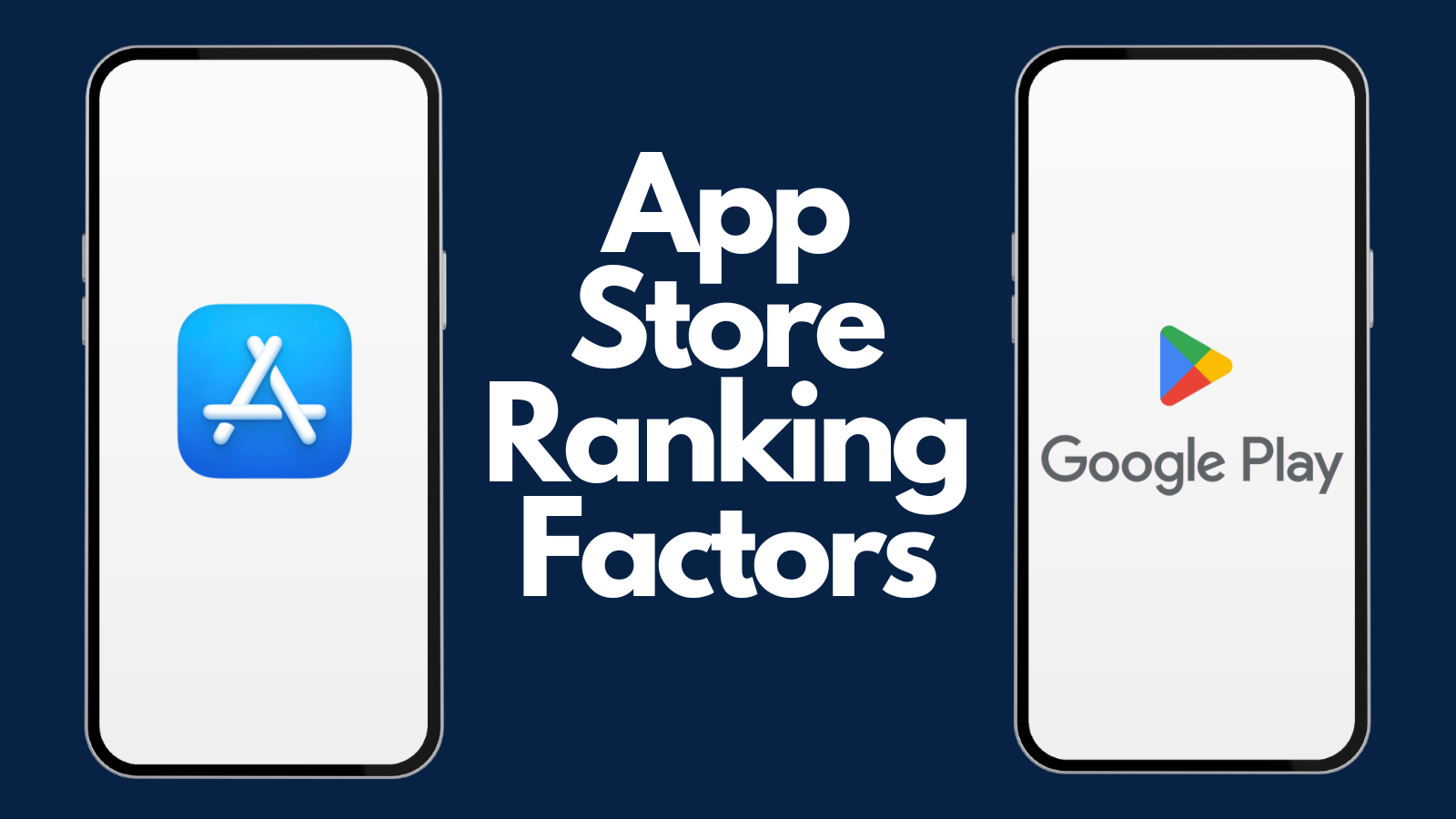
Understanding App Store Ranking Factors (Apple & Google Play)
Understanding App Store Ranking Factors (Apple & Google Play)
Apr 16, 2024When it comes to optimizing your app's visibility and reaching a wider audience, understanding the app store ranking factors is crucial. Both the Apple App Store and Google Play have their own unique algorithms that determine how apps are ranked in search results. By familiarizing yourself with these factors, you can enhance your app's chances of being discovered by potential users.
In this article, we will explore the key factors that impact app store rankings on both the Apple App Store and Google Play. We'll provide insights into how you can optimize your app store listing to improve your app's visibility and increase downloads. So, Let’s get started!
Key Takeaways
App store ranking factors play a significant role in determining the visibility of your app.
The Apple App Store and Google Play have their own unique algorithms for app rankings.
By understanding and optimizing for these factors, you can improve your app's discoverability.
Keyword research, compelling app descriptions, and high-quality visual assets are essential for app store optimization.
Regularly monitoring and iterating your optimization strategy is crucial for long-term success.
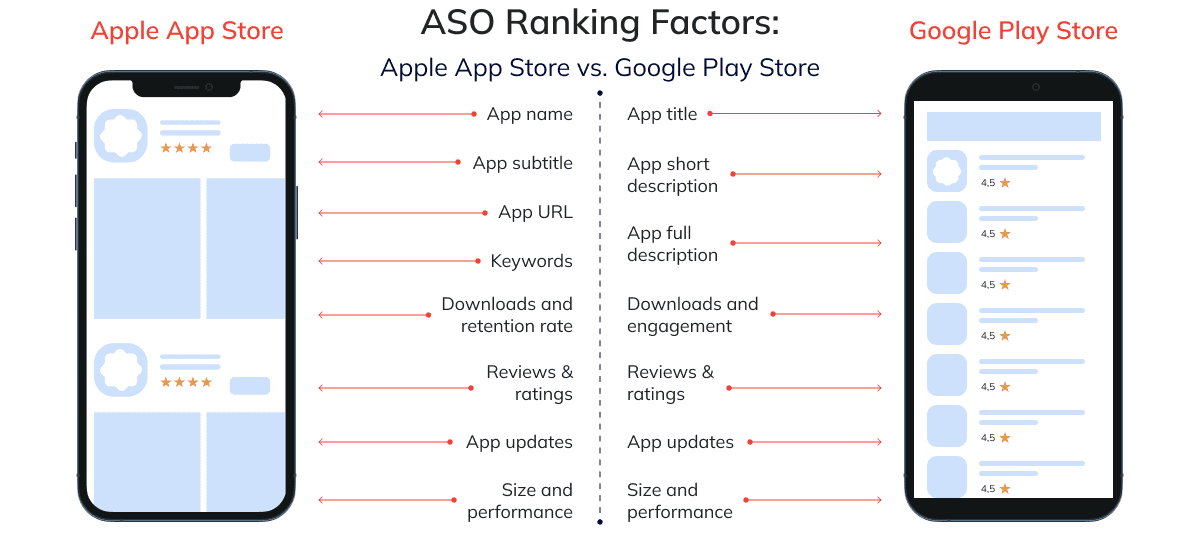
Why App Store Optimization (ASO) is crucial?
Standing out in today's competitive app market is crucial for the success of your mobile app. This is where app store optimization (ASO) plays a key role. ASO includes various strategies to enhance your app's visibility and rankings in search results. By utilizing effective ASO techniques, you can greatly improve your app's chances of being found by potential users.
Importance of App Store Optimization
Crafting ASO strategies for your app can yield multiple benefits:
Boost Visibility: ASO contributes to boosting your app's ranking in search results, enhancing its visibility to potential users. This increased visibility can translate into higher organic app downloads.
Increased Organic Downloads: When your app ranks higher in search results, it attracts more organic traffic. This, in turn, leads to a boost in app downloads without the need for paid advertising.
Higher User Engagement: By optimizing your app's listing using relevant keywords and compelling visuals, you can attract users who are genuinely interested in your app's features and benefits. This results in better user engagement and increased user retention.
Better Conversion Rate: ASO helps you attract the right users who are more likely to convert into loyal app users. By optimizing your app's visuals, descriptions, and other elements, you can effectively communicate your app's value proposition and encourage users to download and engage with your app.
Implementing ASO Strategies
“ASO encompasses a range of strategies and techniques that focus on improving your app's visibility and rankings in app store search results.”
Implementing ASO strategies requires careful attention to various elements of your app's listing. This includes optimizing your app's title, description, and keywords, as well as selecting relevant categories and subcategories. It also involves creating compelling app visual assets such as icons, screenshots, and preview videos that entice users to download your app.
Additionally, monitoring and analyzing your app's performance and user feedback plays a crucial role in refining your ASO strategies over time. By utilizing data-driven insights, you can make informed decisions and iterate on your ASO approach to continually improve the visibility and success of your app.
ASO Strategies | Benefits |
|---|---|
Keyword optimization | Improved search visibility |
Optimized app descriptions | Increased user engagement |
Visual asset optimization | Enhanced app presentation |
User ratings and reviews management | Positive app reputation |
Localization for different regions | Expanded app reach |
By leveraging ASO strategies, you can position your app for success in the competitive app market. The next sections will provide detailed guidance on each aspect of app store optimization, equipping you with the tools and knowledge to optimize your app's visibility and drive organic downloads.
Conducting Keyword Research for App Store Listings
When it comes to optimizing your app store listing, conducting thorough keyword research is a crucial step. By identifying relevant and high-ranking keywords, you can enhance the visibility of your app and attract the right audience. In this section, we will guide you through the process of keyword research, providing valuable insights and techniques to ensure your app stands out in the crowded app market.
1. Analyzing Competitors
One effective strategy for keyword research is to analyze the keywords used by your competitors. Look at the apps that are similar to yours and identify the keywords they are targeting. This will give you valuable insights into the language and terminology commonly used within your industry. You can use tools like App Annie, Sensor Tower, or Mobile Action to gather this data and gain a competitive advantage.
2. Utilizing Keyword Research Tools
There are several keyword research tools available that can help you identify relevant keywords with high search volumes. Tools like Google Keyword Planner, App Radar, and Mobile Action's Keyword Planner provide valuable data on search volume, competition level, and keyword variations. By leveraging these tools, you can discover keywords that align with your app's features, audience, and value proposition.
Pro Tip: Think like your users when conducting keyword research. Imagine what terms they would use to search for an app like yours. By understanding your target audience's language and preferences, you can optimize your app store listing to attract more relevant users.
3. Long-Tail Keywords
While targeting popular keywords is important, it is equally crucial to focus on long-tail keywords. Long-tail keywords are specific phrases that are less competitive but have a higher chance of attracting highly targeted users. For example, instead of targeting the broad keyword "app builder," consider using long-tail keywords like "shopify app builder" or "ecommerce mobile app builder." These specific phrases are more likely to connect with users who are actively searching for an app that caters to their specific needs.
4. Evaluating Keyword Relevance and Search Volume
When conducting keyword research, it's important to evaluate the relevance and search volume of the identified keywords. Relevance refers to how closely the keyword aligns with your app's features and target audience. Search volume, on the other hand, indicates the number of searches that are made using a particular keyword. Prioritize keywords that are both relevant to your app and have a significant search volume to maximize your app's visibility.
5. Optimizing Keyword Placement
Once you have identified the most relevant keywords for your app, it's essential to optimize their placement within your app store listing. Strategically include keywords in your app title, subtitle, description, and even in the app's metadata. However, avoid overstuffing keywords, as it can negatively impact your app's visibility and user experience. The goal is to strike a balance between keyword optimization and providing informative, engaging content that resonates with potential users.
By following these steps and conducting thorough keyword research, you can optimize your app store listing with the right keywords and improve your app's discoverability, leading to increased downloads and user engagement.
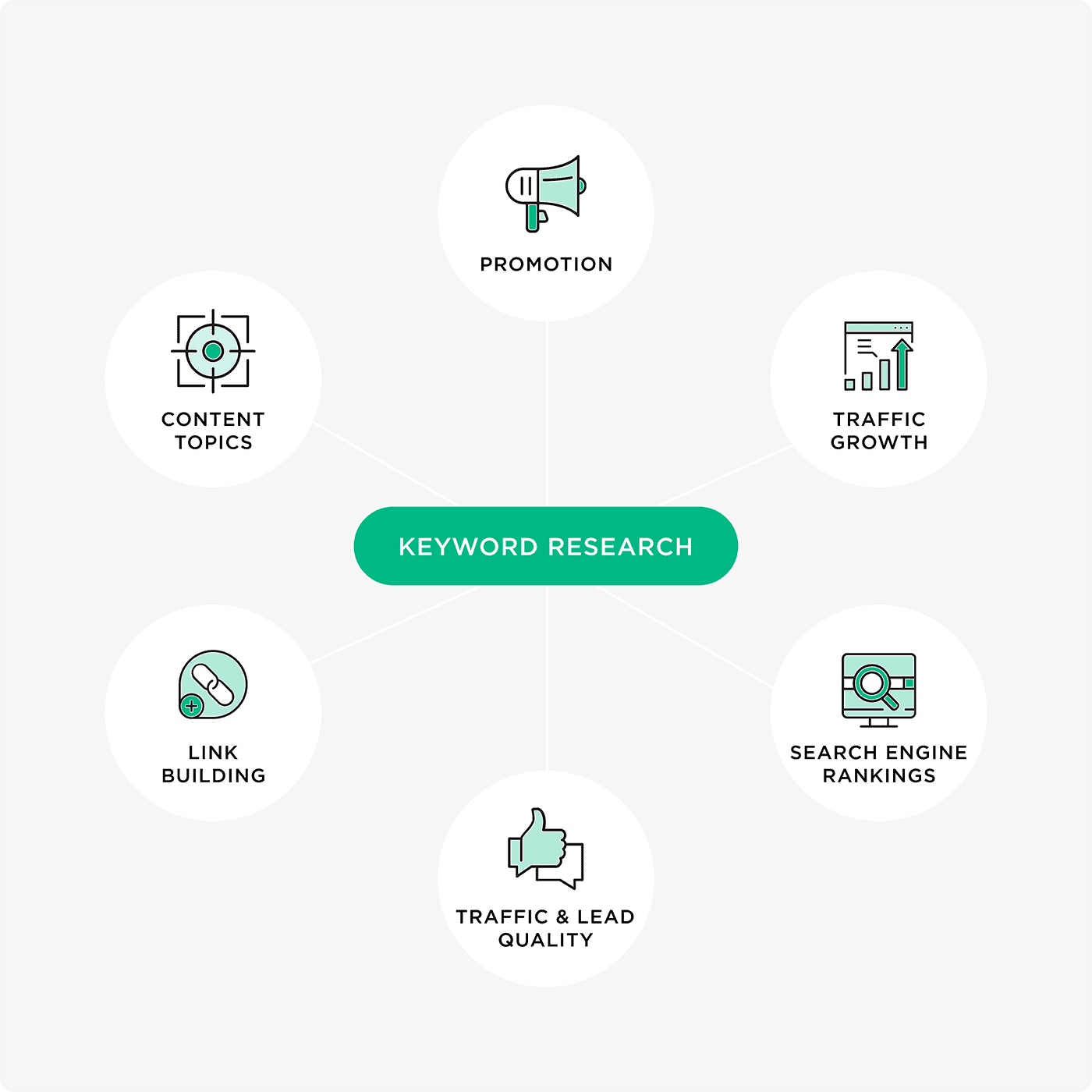
Writing Compelling App Descriptions
Your app description plays a crucial role in attracting users and convincing them to download your app. It should not only provide relevant information about your app but also highlight its unique value proposition and key features. Here are some best practices for writing compelling app descriptions:
1. Understand Your Target Audience
Before writing your app description, it's important to understand your target audience and their needs. Research their preferences, pain points, and what they look for in an app. This will help you tailor your description to resonate with their interests and motivations.
2. Keep it Concise and Clear
Avoid lengthy descriptions that may overwhelm users. Instead, focus on providing concise and clear information about your app's purpose, functionality, and benefits. Use bullet points or short paragraphs to break down the description and make it easier to read.
3. Highlight Unique Features and Benefits
Showcase the unique features of your app that set it apart from competitors. Explain how these features can solve user problems or improve their lives. Use emphasis or strong keywords to draw attention to the most important aspects of your app.
4. Incorporate Relevant Keywords Naturally
App store algorithms consider keywords in your description when determining search rankings. However, it's crucial to incorporate these keywords organically. Stuffing your description with irrelevant or excessive keywords can harm your app's visibility. Integrate keywords naturally within the context of your description.
5. Use Social Proof
Include positive user testimonials, reviews, or awards in your app description to build trust and credibility. This social proof can help users feel confident about downloading your app and encourage them to take action.
"I've been using this app for a month now, and it's changed the way I manage my finances. Highly recommended!" - John Doe, App Store Review
6. Localize Your Description
If your app is available in multiple regions or languages, consider localizing your description. This allows you to tailor your messaging to specific markets, increasing your app's appeal and relevance.
7. Update and Test Regularly
Don't set your app description in stone. Continuously update and test different versions of your description to see what resonates best with your audience. Monitor user feedback and make necessary adjustments to optimize your description over time.
Before | After |
|---|---|
Discover useful tools and features to ease your daily tasks. | Simplify your daily tasks with our powerful, intuitive tools and features. |
Best app for fast and secure transactions. | Enjoy fast and secure transactions with our top-rated app. |
Boost your productivity with our innovative app. | Experience unmatched productivity with our cutting-edge app. |
By following these best practices, you can create compelling app descriptions that drive downloads, engage users, and ultimately contribute to the success of your app.
Optimizing App Titles and Subtitles
In today's competitive app marketplace, having an attention-grabbing and keyword-rich app title and subtitle is crucial for maximizing your app's discoverability. A well-optimized title and subtitle can significantly improve your app's rankings and attract more potential users.
When creating your app title, it's important to strike a balance between creativity and clarity. Your title should accurately represent your app's purpose and content while being catchy and memorable. Incorporating relevant keywords naturally into your title can also help boost your app's visibility in search results.
Consider using your app's main features or its unique selling points in the title to give users an immediate understanding of what your app offers. Remember to keep it concise and engaging, as longer titles may not display fully in app store search results.
In addition to the app title, the subtitle provides you with an opportunity to provide more detailed information about your app. Use this space wisely to highlight key features or benefits of your app that may not be immediately apparent from the title alone. Include relevant keywords in your subtitle to further optimize your app store listing.
Example:
App Title: SleepWell - Relaxing Sounds & Sleep Tracker
Subtitle: Improve Your Sleep Quality with Soothing Sounds and Personalized Sleep Tracking
By optimizing your app titles and subtitles, you can increase the visibility of your app in search results and capture the attention of potential users.
Remember to conduct thorough keyword research, use concise yet descriptive language, and highlight the unique features of your app to create titles and subtitles that resonate with your target audience.
Utilizing Appropriate App Categories and Subcategories
When it comes to optimizing your app store listing, selecting the right app categories and subcategories is vital for improving visibility and reaching the right audience. Categorizing your app correctly can significantly impact the discoverability of your app and increase its chances of being found by users who are genuinely interested in its features and functionalities.
By choosing the most relevant app categories and subcategories, you can ensure that your app appears in the right sections of the app store, making it easier for users to find and download. Moreover, being listed in the appropriate categories can enhance your app's credibility and reputation, as it signals to users and search algorithms that your app aligns with their specific needs and interests.
When selecting app categories and subcategories, it's essential to accurately reflect the core purpose and functionality of your app. Don't attempt to mislead users or artificially optimize your placement by choosing unrelated categories or subcategories. This can lead to negative user experiences and ultimately harm your app's reputation and rankings.
To choose the most suitable categories and subcategories, thoroughly research the available options in the app store guidelines and consider the nature of your app, target audience, and competition. Analyze apps that are similar to yours and observe the categories they are listed under to gain insights into the most relevant options for your app. Note that the app categories and subcategories may vary between the Apple App Store and Google Play, so it's important to understand the guidelines and requirements of each platform.
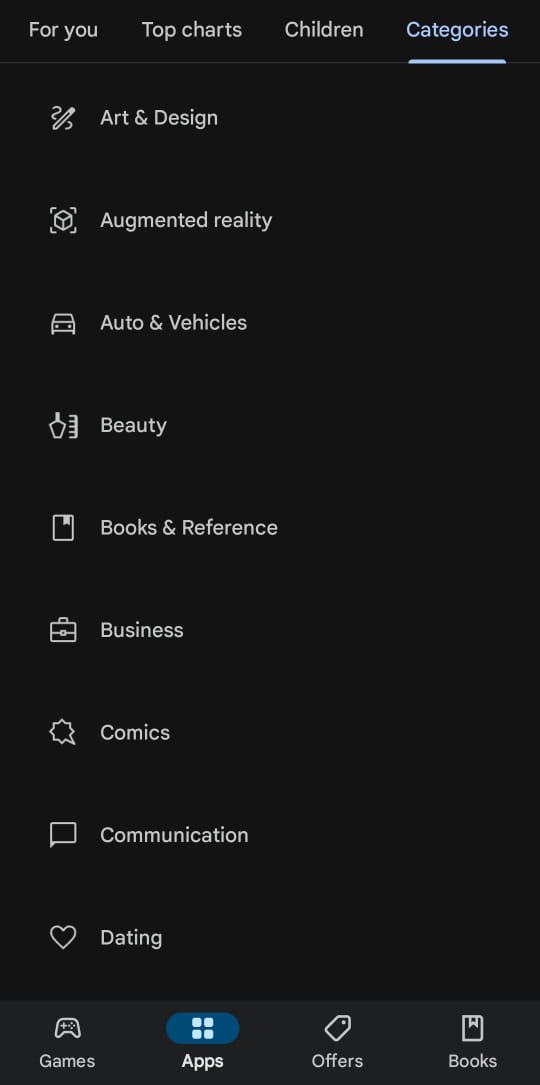
In addition to selecting app categories and subcategories, it's beneficial to include relevant keywords in your app's metadata and description. This can further optimize your app's visibility and searchability within the chosen categories. Conducting keyword research, as mentioned in the previous section, can help you identify the most effective keywords to incorporate into your app store listing.
Benefits of Utilizing Appropriate App Categories and Subcategories | Steps to Select the Right Categories and Subcategories |
|---|---|
Improved app visibility | Thoroughly research available options |
Reaching the right audience | Analyze similar apps and their categorization |
Enhanced app credibility and reputation | Reflect the core purpose and functionality of your app |
Optimized app store placement | Consider app nature, target audience, and competition |
Incorporate relevant keywords in app metadata | Conduct keyword research for effective keywords |
Enhancing App Store Visual Assets
When it comes to app store optimization, the visual assets of your app play a crucial role in capturing user attention and creating a positive first impression. By optimizing your app icons, screenshots, and preview videos, you can significantly increase your app's visibility and attract more downloads.
App Icons:
Your app icon is the first thing users see when browsing through the app store. It should be visually appealing, unique, and representative of your brand or app's core features. To optimize your app icon, consider the following:
Create a simple and recognizable design that stands out among competitors.
Ensure the icon reflects the purpose and functionality of your app.
Use clear and high-resolution graphics for sharpness and clarity.
Test different variations to see which one resonates best with your target audience.
Screenshots:
Screenshots showcase the key features and user interface of your app, allowing potential users to visualize the app's functionality. To optimize your screenshots:
Highlight the most important and compelling aspects of your app.
Arrange screenshots in a logical order that tells a story and guides users through the app's experience.
Showcase different screens, functionalities, and benefits.
Use descriptive captions to provide context and engage users.
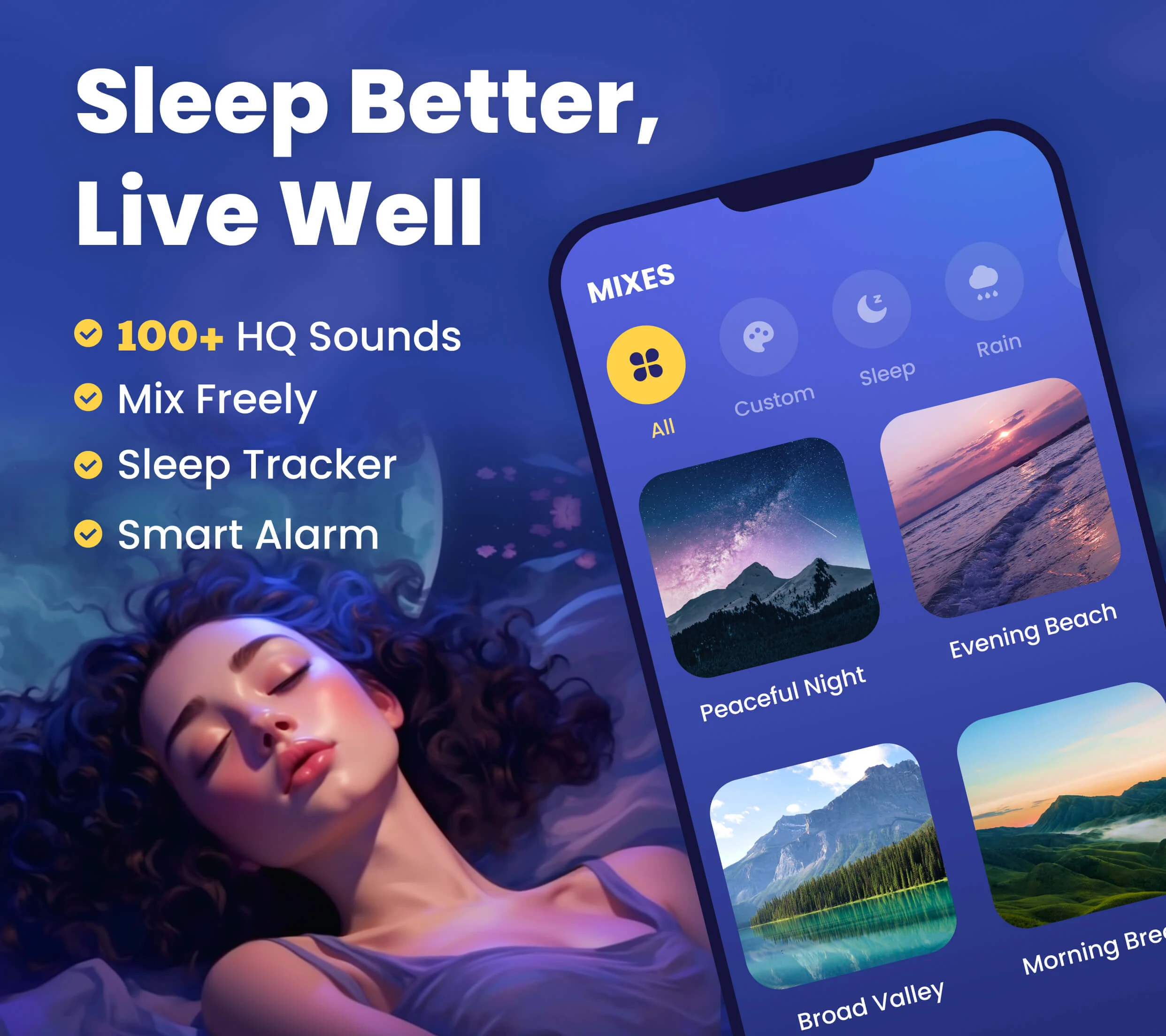
Preview Videos:
Preview videos offer an interactive glimpse into your app's features and user experience. They have become increasingly popular in-app listings. To optimize your preview videos:
Create a short and engaging video that quickly grabs attention.
Showcase the app's unique selling points and highlight its benefits.
Keep the video concise, focusing on the most captivating aspects of the app.
Include a call-to-action at the end of the video, encouraging users to download the app.
Remember, high-quality app icons, screenshots, and preview videos can make a significant difference in users' decision-making process. By optimizing these visual assets, you can increase your app's discoverability, generate more interest, and ultimately boost your downloads and conversions.
Visual Asset | Optimization Tips |
|---|---|
App Icons | Create a visually appealing and representative design. Use high-resolution graphics and test different variations. |
Screenshots | Highlight key features, arrange in a logical order, showcase different screens, and use descriptive captions. |
Preview Videos | Create short and engaging videos, showcase unique selling points, keep the video concise, and include a call-to-action. |
Leveraging User Ratings and Reviews
When it comes to app store rankings, user ratings and reviews play a crucial role. They not only influence the perception of your app but also impact its discoverability. In this section, we will explore effective strategies for leveraging user ratings and reviews to enhance your app's reputation and visibility.
Encouraging Positive Reviews
Positive reviews can significantly boost your app's credibility and encourage other users to download it. To encourage positive reviews, consider implementing the following strategies:
In-app prompts: Prompt users to rate and review your app at strategic points in their user journey, such as after completing a task or achieving a milestone.
Offer incentives: Reward users who leave positive reviews with special in-app rewards or discounts to encourage their engagement.
Deliver exceptional user experiences: Focus on creating an app that exceeds user expectations, providing them with a seamless and enjoyable experience that motivates them to leave positive reviews.
Social media engagement: Use your social media channels to actively engage with your users, encouraging them to share positive feedback and reviews.
Implementing these strategies will help increase the number of positive reviews for your app and improve its overall rating.
Managing Negative Feedback
Negative feedback is inevitable, but how you handle it can make a significant difference in maintaining your app's reputation. Follow these strategies to effectively manage negative feedback:
Respond promptly: Address negative reviews and feedback promptly, showing users that their concerns are being acknowledged and taken seriously.
Provide solutions: Offer solutions or alternatives to users who have expressed dissatisfaction, demonstrating your commitment to resolving their issues.
Show empathy: Respond to negative feedback with empathy, understanding the user's perspective and expressing genuine concern for their experience.
Continuous improvement: Use negative feedback as an opportunity for growth and improvement. Regularly analyze user feedback to identify patterns and implement necessary changes.
By effectively managing negative feedback, you can mitigate its impact on your app's reputation and demonstrate your commitment to providing a positive user experience.
Displaying User Ratings and Reviews
Incorporating user ratings and reviews into your app store listing can help potential users make informed decisions and build trust in your app. Consider the following practices:
Highlight positive reviews: Showcase a selection of positive reviews that highlight your app's key strengths and features.
Include average rating: Clearly display your app's average rating to provide an overall snapshot of user satisfaction.
Sort by relevance: Allow users to sort reviews by relevance, helping them find the most helpful and informative feedback.
Keep it authentic: Avoid fake or manipulated reviews, as they can damage your app's credibility and trustworthiness.
User Ratings and Reviews | Benefits |
|---|---|
Influences app store rankings | Improves discoverability and visibility of your app |
Builds trust and credibility | Attracts potential users and encourages downloads |
Provides valuable feedback | Identifies areas for improvement and enhances user experience |
By leveraging user ratings and reviews effectively, you can not only enhance your app's reputation but also improve its discoverability and overall success in the app stores.
Localizing Your App Store Listing
Localizing your app store listing for different regions and languages can bring significant benefits to your app's visibility and user engagement. By adapting your app's content to suit the preferences and cultural nuances of specific target markets, you can attract a wider audience and increase your app's chances of success.
When it comes to app store localization, there are several key aspects to consider. First and foremost, translating your app's title, description, and keywords into the local language is essential. This allows potential users who search for apps in their native language to find and understand your app more easily.
Furthermore, tailoring your app's visuals, such as screenshots and videos, to resonate with the target market can greatly improve user engagement. Localizing the visuals not only ensures that they are culturally relevant but also helps users visualize how the app will benefit them.
"App store localization opens up new opportunities for app developers to reach a global audience. By speaking the language of your users and tailoring your app to their needs, you can establish a strong connection and build trust, ultimately driving more downloads and revenue."
- John Smith, App Localization Expert
Localized User Support
Another vital aspect of app store localization is providing localized user support. This involves translating and adapting your app's customer support channels, including FAQs, help articles, and in-app messaging, into the local language. Being able to communicate with users in their native language helps foster trust and provides a better overall user experience.
In addition, understanding and abiding by the local regulations and legal requirements in each target market is crucial. This includes compliance with data privacy laws and other relevant regulations specific to the region.
The Benefits of App Store Localization
App store localization offers various advantages for app developers. Firstly, it increases the discoverability of your app in local app stores, making it more likely to appear in relevant search results. This improved visibility can significantly boost organic downloads and user acquisition.
In addition, by catering to the unique preferences and cultural norms of different regions, your app is more likely to resonate with local users. This enhances user engagement, drives positive reviews, and increases user retention.
Benefits of App Store Localization |
|---|
Expanded global reach and user base |
Improved visibility in local app stores |
Increased user engagement and retention |
Enhanced customer support and user satisfaction |
In a global marketplace where competition is fierce, app store localization can give your app a competitive edge. By presenting your app in a language and format that resonates with local users, you can establish a strong connection and build trust, ultimately driving more downloads and revenue.
Monitoring and Iterating Your App Store Optimization Strategy
After implementing your app store optimization (ASO) strategy, it's essential to actively monitor and iterate your approach. Regularly assessing your app's performance and making data-driven improvements will help you stay competitive in the app market. Here are some tools and techniques you can use to effectively monitor and optimize your app store presence:
1. App Analytics
Utilize app analytics platforms, such as Google Analytics or App Annie, to gather valuable insights into your app's performance. Monitor key metrics like downloads, user engagement, retention rates, and in-app purchases. Identify trends, identify areas of improvement, and track the impact of your ASO efforts.
2. User Feedback
Pay attention to user feedback and reviews. Both positive and negative reviews can provide valuable insights into user expectations and areas for improvement. Address any issues promptly and consider incorporating user suggestions into future updates.
3. A/B Testing
Conduct A/B testing to compare different variations of your app's visuals, descriptions, and keywords. This process allows you to identify what aspects of your app store listing resonate best with your target audience. By gathering data on conversion rates and user engagement, you can continually refine your ASO strategy.
"Continually monitoring and iterating your app store optimization strategy is vital for long-term success in the app market." - Jane Smith, ASO Expert
4. Competitor Analysis
Regularly analyze your competitors' app store presence. Identify keywords they are targeting, track their rankings, and analyze their visual assets and descriptions. This analysis can provide valuable insights into areas where you can differentiate and improve your own app store listing.
5. Stay Updated on Industry Trends
Stay informed about the latest trends and updates in app store optimization. Follow industry blogs, attend webinars, and connect with other ASO professionals. By staying up-to-date, you can adapt your strategy to the changing algorithms and best practices.
Monitoring and Iterating Tips: | Benefits: |
|---|---|
Regularly track keyword rankings and adjust your app store listing accordingly | Increase your app's visibility and organic downloads |
Analyze user behavior and engagement metrics to identify areas for improvement | Enhance user experience and retention rates |
Monitor customer feedback and reviews to address issues promptly | Improve app ratings and increase user satisfaction |
By continuously monitoring and iterating your app store optimization strategy, you can maximize your app's visibility, attract more users, and ultimately increase your chances of success in the competitive app market.
Conclusion
Optimizing your app store listing for both the Apple App Store and Google Play is essential for improving your app's visibility and attracting more users. By implementing the strategies and tips discussed in this article, you can enhance your app's rankings and overall success.
App store optimization (ASO) plays a crucial role in increasing your app's discoverability. By conducting thorough keyword research, writing compelling app descriptions, optimizing titles and subtitles, selecting appropriate categories and subcategories, and leveraging high-quality visual assets, you can significantly improve your app's visibility in search results.
In addition, user ratings and reviews hold great influence over app store rankings. Encouraging positive reviews and effectively managing negative feedback can help boost your app's reputation and attract more users. Furthermore, localizing your app store listing for different regions and languages can broaden your app's reach and engage a global audience.
Remember, monitoring and iterating your app store optimization strategy is crucial for staying competitive and adapting to changing market trends. By continuously analyzing your app's performance and making data-driven improvements, you can achieve long-term success and maximize your app's potential in the app stores.
FAQ
What are the key factors that impact app store rankings?
The key factors that impact app store rankings include app store optimization (ASO), keyword relevance, app downloads and engagement, app ratings and reviews, and app updates and freshness.
Why is app store optimization (ASO) important?
App store optimization (ASO) is essential because it helps improve your app's visibility in search results. By optimizing various elements of your app store listing, such as keywords, app description, and visual assets, you can increase the chances of your app being discovered by potential users.
How do I conduct keyword research for my app store listing?
To conduct keyword research for your app store listing, you can use various tools and techniques. Start by brainstorming relevant keywords and then use keyword research tools, such as Google Keyword Planner or App Store Connect Search Ads, to identify high-ranking and popular keywords. Also, analyze your competitors' keywords for insights.
How can I write compelling app descriptions?
To write compelling app descriptions, focus on highlighting the unique features and benefits of your app. Use persuasive language, keep it concise, and include relevant keywords naturally. Structure the description in a way that grabs users' attention and encourages them to download your app.
How can I optimize app titles and subtitles?
To optimize app titles and subtitles, include relevant keywords that accurately represent your app. Try to create catchy titles that grab users' attention. However, ensure that the title is concise and clear. Additionally, utilize subtitles to provide more descriptive information about your app's key features.
Why is selecting the right app categories and subcategories important?
Selecting the right app categories and subcategories is important because it helps your app reach the right audience. By categorizing your app correctly, you increase its visibility among users who are specifically searching for apps in those categories. This can also improve your app's chances of ranking higher within those categories.
How can I enhance app store visual assets?
To enhance app store visual assets, ensure that you have high-quality app icons, screenshots, and preview videos. Use visually appealing designs that accurately represent your app and its key features. Highlight the most compelling aspects of your app through engaging visuals that will attract users' attention.
What is the role of user ratings and reviews in app store rankings?
User ratings and reviews play a significant role in app store rankings. Positive ratings and reviews can improve your app's reputation and increase its visibility. Encourage your users to leave positive feedback and manage negative reviews effectively to maintain a good overall rating.
Why should I localize my app store listing?
Localizing your app store listing allows you to target different regions and languages, expanding your app's reach. By catering to the language and cultural preferences of specific regions, you can attract more users who are more likely to engage with your app. This can positively impact your app's visibility and user engagement.
What is the importance of monitoring and iterating my app store optimization strategy?
Monitoring and iterating your app store optimization strategy is crucial for keeping up with changes in the app stores' algorithms and user preferences. By tracking your app's performance, analyzing data, and making data-driven improvements, you can continuously optimize your app store listing and improve your app's rankings and visibility.
Unlock Your Store's Full Potential – Discover How with a Free Demo
Get in touch© 2023 Appbrew. All rights reserved.
Privacy Policy